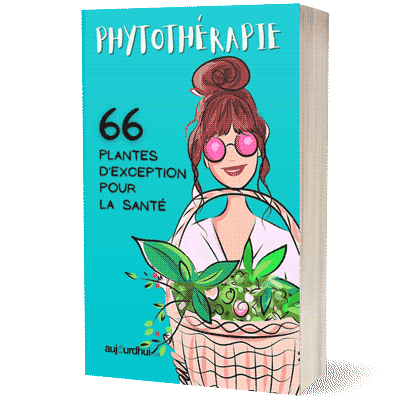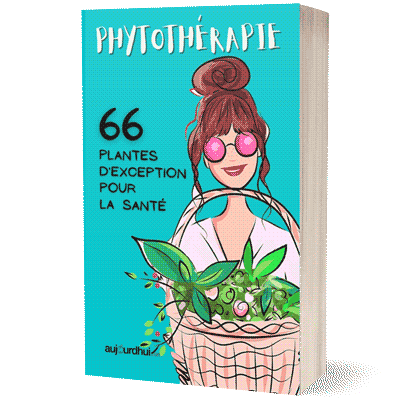Besides its culinary interest, sage is a plant with various strengths that relieves the unpleasant symptoms of menopause. This is particularly the case with the famous hot flashes which affect more than half of women at this particular stage of their existence. We come back to the benefits of sage!
IDENTITY RECORD
Name: Sage
Scientific name : Salvia officinalis
Family: Lamiaceae
Parts used: leaves
Indications: sore throat, mouth ulcers, sore throat, cough, pharyngitis, fever, menopause, hot flashes
Preparation: infusion, decoction
The sage is a shrub 80 cm high cultivated in sunny and dry regions more precisely in the basin of the Mediterranean. It is harvested in summer and its oval leaves are gray-green in color. Its taste is pronounced, both bitter and camphor.
It is a medicinal plant of the lamiaceae family whose sage leaves are also considered to be aromatic herbs.
The sage is well known for its virtues in herbal medicine has been proven in the relief of hot flashes in women going through menopause. It acts on hormonal upheavals.
An excellent aphrodisiac
In the woman at the menopause, the ovaries produce less and less estrogen. This decrease causes a hormonal imbalance which gives rise to hot flashes.
Sage contains folliculin, a substance whose action is similar to that of estrogen in women. It will thus stimulate the production ofestrogen, help reduce hormonal imbalance as well as the frequency and intensity of hot flashes.
Sage is also an excellent aphrodisiac useful during menopause where we often notice a decrease in sexual desire. It stimulates the adrenal glands, boosts the fertility, regulates the menstrual cycle and calms the pains associated with it.
The health benefits of sage
Taken in various forms, sage has many virtues thanks to the vitamin K and ursolic acid which have an immunostimulatory and anti-inflammatory action. Also, thujone (50%), the essence of sage, has an antiseptic and it stimulates blood flow.
Also, tannins, phenolic acids and flavonoids give it toning properties, astringent and antispasmodics.
- Medicinal sage is recommended to alleviate the inconvenience of excessive sweating, because it has an astringent action.
- It has properties relaxing and it is used in gentle massage to calm menstrual pain.
- It is useful in case of fever, flu syndrome, difficult digestion, bloating …
- The sage infusion helps get rid of dandruff while giving shine to hair.
- Sage is recommended in cases of depression,asthenia, dizziness.
- It has anti-inflammatory properties and calms sore throats and smokers’ coughs.
- Fresh sage leaves have disinfectant properties and healing and they are used in the event of a bite or sting.
- Sage also has many effects on the skin especially on the formation of wrinkles.
- This plant helps to stimulate memory, reduces stress and would also fight againstAlzheimer’s.
How to take advantage of the benefits of sage?
Sage is generally used in the form of tisane (infusion) oressential oil to cure diseases. It is recommended not to use sage for more than 2 weeks internally and one week locally.
You can buy sage leaves in pharmacies, herbalists and organic stores. It can be associated with other plants like hops, white willow, etc. It is used in many ways:
- Dried leaves: 1 to 3 g infused for 5 to 10 minutes in 150 ml of boiling water, 3 times a day
- Tincture: 25 drops, 3 times a day
- Liquid extract: 1 to 3 ml, 3 times a day
- Dry extract: 180 to 360 mg, 3 times a day
Besides the internal or external uses, we can integrate sage intofood. It can be added to sauces or broths, mixed with salads, seasoned meats, flavored desserts.
We also find sage in the composition of food supplements as is the case in the solution Menopause ofActinutrition.
Contraindications and adverse effects
If we follow the dosages, sage only very rarely causes undesirable effects, which result in nausea or vomiting. But beware, beyond 15 g per day, it can cause palpitations, hot flashes and dizziness.

Find this plant and more than 60 others (also exceptional) in our Herbal medicine guide
Click here to download it for free
Prolonged use of the alcoholic extract oressential oil sage is not recommended because it can be toxic to the nervous system and cause seizures. This plant is not recommended for people epileptics and in pregnant women.
Sage tea recipe
To prepare sage tea:
- Combine 1 to 1.5 g of dried sage leaves for 200 ml of water.
- Bring the water to a boil, then pour it over the sage leaves. Cover and let steep for about ten minutes.
- Strain and drink a cup of this infusion several times a day, depending on the symptoms.
Sage tea can also be used as a gargle in case of sore throat, or for foot baths in case of excessive perspiration. In this case, count 5 to 8 g of sage leaves for 1 l of water. Soak the feet for about twenty minutes in lukewarm water.
The mysterious powers of sage
Did you know ? Traditionally, sage has long been used to ensure a long life, sometimes even immortality. It is worn to gain wisdom, and its leaves are used in many silver and healing rituals.
To protect yourself from the evil eye, all you have to do is wear a horn filled with sage as an amulet, in bouquets above the doors, in bushes around the house. Sage protects against bewitchment and lightning.
And you, how do you use sage? Is it more to flavor your meals or for the therapeutic virtues of its leaves? Tell us in the comments.













